Boat Passes Chinese Landscape
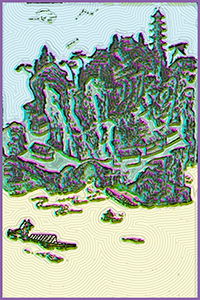
From the Internet Archive Universal Library collection, an illustration from a Chinese book. The book is titled, in Chinese, ????????????(???), which my Chinese-to-English translator gives as "Mr. Wu criticized Mr LEE Cheuk-yi Outlaws of the Marsh (32)" (Link1). Probably something more like Outlaws of the Marsh, a suitable title for a pulp best-seller in any society. What I like about this image is the sense of slow, downstream drifting of the boat (even with two oarsmen). I also like the landscape it passes -- a small village with a bridge, a riverside road, and then an impossible configuration of hills and trees beyond. I've never been to China, but can such landscapes really be? The book was scanned and donated by the China-US Million Book Digital Library Project. Size at 150 pixels-per-inch is 9.8" wide x 14.8" high.
For maximum effect with my images, click on the image until it is full-size, which may be larger than your computer screen.
Sources:
Link1: archive.org/details/02111804.cn
Tuesday, January 7, 2014
Polish Transport 1958
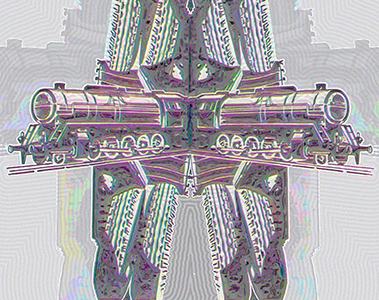
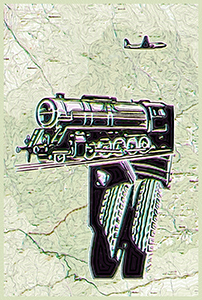
The Internet Archive's scans of the Library of Congress' "X-Collection" -- a now-obsolete collection of miscellaneous boxes full of pamphlets and brochures -- includes two 1958 course catalogues from the Polish Railway Institute (Link1). One cover show a freight locomotive, the other shows a pair of truck tires, rendered in an assured, but abstracted, pen-and-ink style. My Art Club has an upcoming show devoted to Travel and Transport with a delivery deadline of Jan. 24-25. Will this combination of the two drawings be my entry? Putting this here to start thinking about it. I want to improve my framing technique -- previously I just mounted pictures on foam-kore in dorm poster fashion. So I bought two IKEA frames with an inside-mat display size of 15.25" x 19.25" and a unmatted display size of 19.75" x 27.5", but I'm afraid these size constraints led me to make some bad design decisions on this one. I did another version, on the right, with a map (Link2) of a recently opened European Dark-sky preserve in the background.
Besides this open show -- which is optional -- I've also been invited to submit five works to exhibit in the Club's Downstairs Gallery. It's exciting, but I'll be a busy boy in the weeks ahead. Another looming deadline: Feb. 14 for a decision on whether to run for the Co-op Board again.
For maximum effect with my images, click on the image until it is full-size, which may be larger than your computer screen.
Sources:
Link1: archive.org/details/xcollection2207B
Link1: commons.wikimedia.org/wiki/File:Boto-mapa-big.jpg
http://commons.wikimedia.org/wiki/File:Boto-mapa-big.jpg
Friday/Saturday, January 17-18, 2014
Lighthouse Fixture
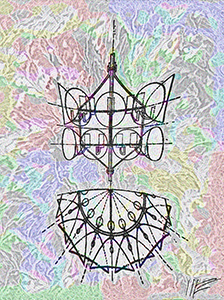
From a new addition to the Internet Archive list, École Nationale des Ponts et Chaussées of Paris, a two-century-old Engineering institute: diagram of a rotating light from the 1842 Instruction sur L'Organisation et La Surveillance du Service des Phares [Lighthouses] et des Fanaux [Lights] des Côtes de France displayed against the interesting pattern found on the report's binding. Note that for the first time, I am including my personal signature/logo in the lower right hand corner.
Put together my five-work submission (by invitation) at the Bob Jackson Gallery in the basement of the Plastic Club. Here's my listing of works.
For maximum effect with my images, click on the image until it is full-size, which may be larger than your computer screen.
Sources:
Link1: archive.org/details/ENPC02_OUV_8_6636_C389_1842
Wednesday, January 22, 2014
Truck Camouflage
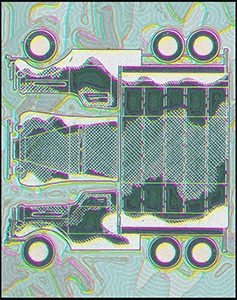
Again from a government documents collection, here is a crude diagram to train troops to paint a truck in camouflage, from the 1942 mimeographed book Camouflage Training Manual For The Air Service Command (Link1). It is superimposed on a modern camouflage pattern, barely recognizable, the Chinese People's Liberation Army Type-99 (Link2) pattern.
For maximum effect with my images, click on the image until it is full-size, which may be larger than your computer screen.
Sources:
Link1: http://archive.org/details/CamouflageTrainingManual
Link1: en.wikipedia.org/wiki/Type_99_%28camouflage%29
Tuesday, January 21, 2014
Witchy Woman
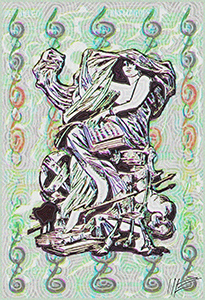
From another reprint of undated (probably early 20th-century) pulp edition of El libro de San Cipriano (Link1), a collection of magic spells, talismans, and amulets attributed -- almost certainly falsely -- to Saint Cyprian of Antioch (Turkey), a drawing of a woman on a throne surrounded by the tokens of magic. This is overlaid on a page from the 1905 A History of Architecture on the Comparative Method, showing British moldings (Link2). That is accented by one of August Lepere's decoration from the Huysmans book Against Nature (Link3). Signature included.
Sometimes people request seeing the originals -- the raw material -- I use in my "re-mixes". Here are the three described above:
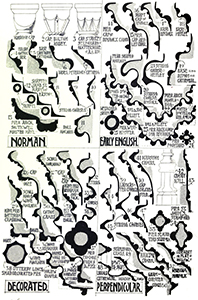
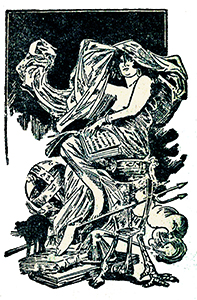

I suspect that showing the source images detracts from the viewer's understanding of my work; it may be distracting.
For maximum effect with my images, click on the image until it is full-size, which may be larger than your computer screen.
Sources:
Link1: archive.org/details/ellibrodesancipr00surf
Link2: archive.org/details/historyofarchite00fletuoft
Link3: archive.org/details/gri_33125012235582
Sunday, January 26, 2014
Texture from Dutch Surinamese Plant
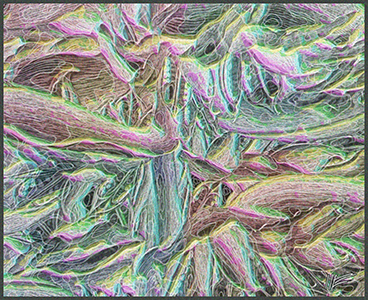
Another one from the Biodiversity Heritage Library, the 1851 Dutch Stirpes Surinamenses Selectae (Link1) [Rough translation: Selected Plant Species from Surinam] has a large illustration of a plant called Phenakospermum Guianense, which grows "to over [32 feet] in height but can be felled with a single blow with a machete." This treatment takes the illustration and overlays three copies of it, blurring its structure and turning it into a texture -- with distortion added as a final touch. Its seed-pods can still be recognized in the top center. The history of Dutch Surinam is not a proud moment in Western European history; sugar and coffee plantations in the South American country were worked by brutally mistreated African slaves. Slavery was abolished in 1863.
For maximum effect with my images, click on the image until it is full-size, which may be larger than your computer screen.
Sources:
Link1: archive.org/details/stirpessurinamen00miqu
Monday, February 3, 2014
Housewives on Fences
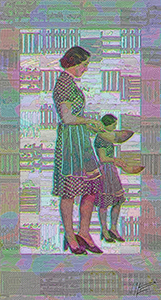
Turning now to the Building Technology Heritage Library, an always entertaining
a collection of housing plans and construction techniques, a housewife (or two) in dotted dresses stir a salad bowl, from a kitchen display in the 1942 Farm Idea Book (Link1). Their figures are displayed on a collage of suburban fences from the 1960 Modern Wood Fences (Link2).
For maximum effect with my images, click on the image until it is full-size, which may be larger than your computer screen.
Sources:
Link1: archive.org/details/JohnsManvilleTheFarmIdeaBook0001
Link2: archive.org/details/WeyerhaeuserModernWoodFences0001
Tuesday, February 4, 2014
Strong Man Hoists Wagon Wheel
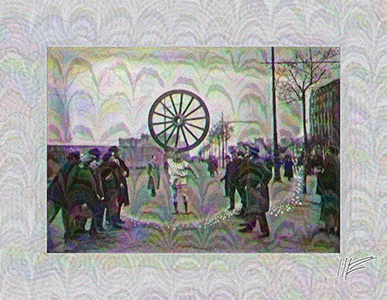
From Gallica, a 1921 newspaper photograph Homme Tenant en Equilibre sur son Front une Roue de Charriot (Link1), showing a strong man balancing on his forehead a heavy wheel, before a crowd in a Parisian park. The white powdery area is a defect in the negative. The image is superimposed (empatterned) on an endpaper marblized pattern from the 1858 L'Art de Dompter les Chevaux (Link2) [Translation: The Art of Taming Horses].
For maximum effect with my images, click on the image until it is full-size, which may be larger than your computer screen.
Sources:
Link1 gallica.bnf.fr/ark:/12148/btv1b53046649g
Link2 gallica.bnf.fr/ark:/12148/bpt6k6580037n
Wednesday, February 26, 2014
Another Three Treatments of Same Material
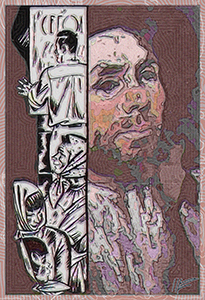
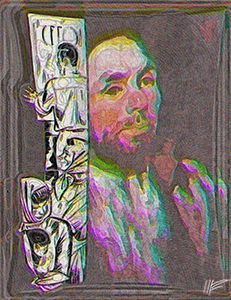
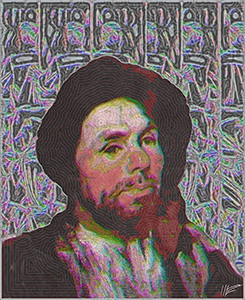
Going through considerable artistic angst these days.... Here, a combination of two images: a 19th century painting of a man's face, in a Warsaw museum, taken from a 1985 issue of the Polish Magazyn Polski (Link1). Next to it (or behind it) is a drawing panel from another Polish magazine, a 1969 edition of Wiejska Mlodziez. Two out of three of these images will be soon dispatched to the Rejects page.
For maximum effect with my images, click on the image until it is full-size, which may be larger than your computer screen.
Sources:
Link1 archive.org/details/MagazynPolski31985
Link2 archive.org/details/WiejskaMlodziez31969ZSRR
Tuesday, March 4, 2014
Three Treatments of Same Material
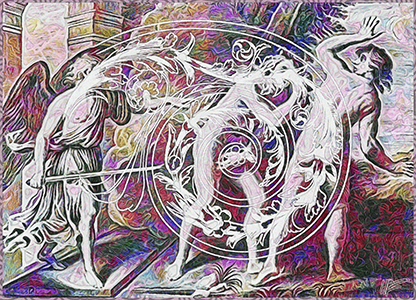
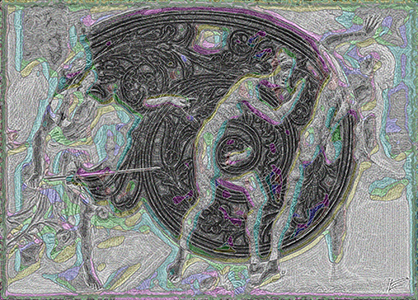
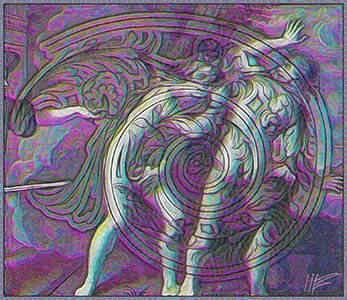
Another threesome, combining the same two images images. The first is an old-style engraving from the 1791 L'Etruria Pittrice, Ovvero, Storia della Pittura Roscana, Dedotta dai Suoi Monumenti che Si Esibiscono in Stampa dal Secolo X (Link1), showing a winged angel holding a sword, banishing Adam and Eve from the Garden of Eden. The second element is an architectural fluorish from the 1568 Reigle Generalle d'Architectvre des Cinq Manieres de Colonnes (Link2). Not happy with the first two images, they will probably be dispatched to the Rejects page soon, but I like the third.
For maximum effect with my images, click on the image until it is full-size, which may be larger than your computer screen.
Sources:
Link1 archive.org/details/gri_33125008688240
Link2 archive.org/details/gri_33125009314002
Sunday, March 2, 2014
Illumination and Mermaid Drowning Sailor
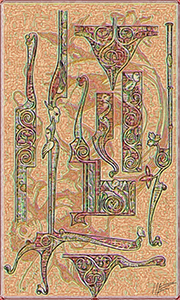
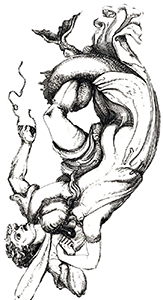
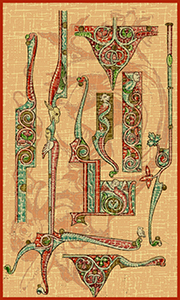
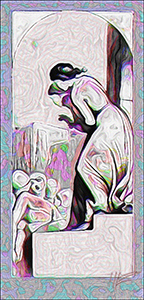
A page of examples from the 1861 The History, Theory, and Practice of Illuminating, showing illuminated letters from 13th century manuscripts. They are superimposed on barely visible image from the 1842 Book of British Ballads, illustrating a Scottish ballad telling how a handsome sailor was carried
off by a mermaid and kept in a grotto beneath the sea until he escaped and returned to his home-town sweetheart. The sailor's struggles with the mermaid are shown in the center. The image on the left is my "artistic" image; these days I mainly concentrate on a luxuriant richness of texture. The third image is an intermediate stage of the treatment -- before I get into heavy texturizing; sometimes I wonder if I go too far and should stop at an earlier stage. The fourth image is a treatment of one of the illustrations from the ballad book.
For maximum effect with my images, click on the image until it is full-size, which may be larger than your computer screen.
Sources:
Link1 archive.org/details/historytheorypra00tymm
Link1 archive.org/details/gri_33125012902363
Friday, March 7, 2014
Trenchcoat Girl in Fern Wood
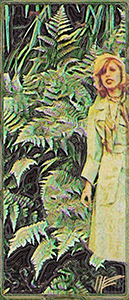
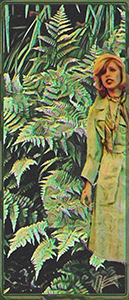
A fashion photo from the 1975 Polish magazine Kobieta I Zycie (Link1) superimposed on a picture of ferns from a 1984 edition of the Pteridologist (Link2), and all again dimly superimposed on an unidentifiable patch from the 1877 Journal de Micrographie (Link3). The left hand version of the image contains my usual texturizing. The right hand version does not. I am considering lightening up on the texturizing...
For maximum effect with my images, click on the image until it is full-size, which may be larger than your computer screen.
Sources:
Link1 archive.org/details/KobietaIZycie23XI1975
Link2 archive.org/details/pteridologistbri5120brit
Link3 archive.org/details/journaldemicrogr1187unse
Monday, March 10, 2014
Polish Columnist and Sea Creatures
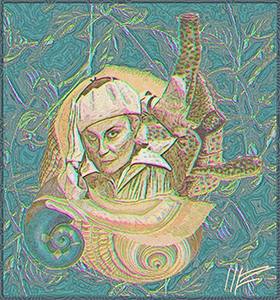
A photo of a columnist from 1975 edition of the Polish magazine Kobieta I Zycie (Link1) superimposed on a collage of strange and delicately-colored sea creatures from the 1791 Testacea Utriusque Siciliae eorumque Historia et Anatome Tabulis Aeneis Illustrata (Link2) Finally, superimposed on a plant illustration from the 1882 Field and Garden Crops of the North-western Provinces and Oudh (Link3). ... Need to do a pruning of this page soon, sending some images to the Rejects page .
For maximum effect with my images, click on the image until it is full-size, which may be larger than your computer screen.
Sources:
Link1 archive.org/details/KobietaIZycie23XI1975
Link2 archive.org/details/TestaceautriusqIVPoli
Link3 archive.org/details/fieldgardencrops03duth
Monday, March 10, 2014
Canadian Trading Post, Text Experiments
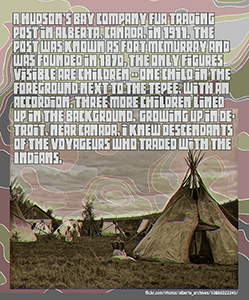
A picture (Link1) from the archives of the Province of Alberta, which recently joined Flickr Commons. Descriptive text is included in the image -- a big change, motivated mainly by frustration at gallery hangings that do not include text, but also by may fascination with typography. The font is Beethoven, a 2005 font by Canadian font-maker Daniel Gauthier. His page is here. Getting the type into the design was rough. Had to make an intermediate PDF from Photoshop, import that into InDesign, export the type into PDF, and re-import that into Photoshop. Ridiculously clumsy.
For maximum effect with my images, click on the image until it is full-size, which may be larger than your computer screen.
Sources:
Link1 flickr.com/photos/alberta_archives/10860322245/
Friday, March 14, 2014
Voluptuous Game Heroine and Avant-Garde Film Frames
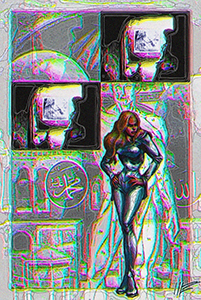
Lower right, a figure of a female character in a 1993 Swedish role-playing game, Mutant Chronicles (Link1), a pen-and-paper game that went on to become a movie. The text is Swedish so I don't know her name, but I recognize that her ballooning bust and impossibly tiny waist makes her perfect for the 1993 teenage boy demographic. Images behind her are from a 1974 book Visionary Film: The American Avant-Garde (Link2). True to the avant-garde nature of the material, it is difficult to describe what is going in the selected frames. One is from Larry Jordan's film Patricia Give Birth to A Dream by the Doorway, which shows a girl and a cat staring out a window and apparently shifts from the cat's view to the girl's view. Another film still is captioned: "Phantasmagoria within the Cultic Center" in Larry Jordan's film Sophie's Place.
For maximum effect with my images, click on the image until it is full-size, which may be larger than your computer screen.
Sources:
Link1 archive.org/details/Mutant_Chronicles_Regler_-_Grundregler_Andra_utgavan_Mutant_Chronicles_-_Andra_Utgavan_Gothmog
Link2 archive.org/details/Visionary_Film_The_American_AvantGarde
Wednesday, March 12, 2014
Role-Playing Game & Eye Shadow
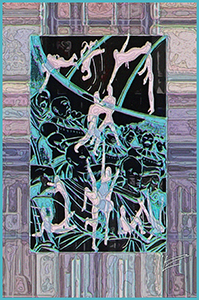
Elements in the center are from a "Gamebook" for a role-playing game, The Way of the Tiger 5: Warbringer (Link1), set on the imaginary world called Orb. Players make decisions and then follow alternate paths to determine the outcome of various political and military maneuvers. (I played four turns, and died because my avatar was horribly disfigured after I placed an emerald orb into my empty eye socket -- don't ask!) In pink, there are diagrams of the various ninja moves that are used in the game's military activities. In blue, there is a drawing of the "Boule," the governing body of the planet Orb. The frame is composed from an advertisement in the 2007 Seventeen Magazine (Link2), showing the various shades available in one brand of eye shadow. (I have always loved the pastel palette of women's makeup.) This is a weird, experimental image, impossible to decipher, and it may be headed for the Rejects page.
For maximum effect with my images, click on the image until it is full-size, which may be larger than your computer screen.
Sources:
Link1 archive.org/details/The_Way_of_the_Tiger_5_Warbringer
Link2 archive.org/details/SeventeenMagazine2007-05
-->
Wednesday, March 12, 2014
Diderot Encyclopedia and Little Girl
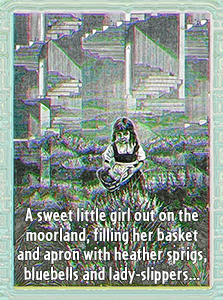
"...She is not alone, though you see no one with her. But her eyes tell the tale; she is in the wake of some one, an elder sister or a rollicking brother, who stalks along leading the way. What pleasure equals that of strolling among the bushes, tall grass, and wild flowers in the early summer days, drinking deep draughts of pure air, laden with the scent of the apple and hawthorn blossoms!" This is the notation for the engraving of the painting Gathering Wildflowers in an 1889 Dominion Illustrated (Link1), a Canadian picture magazine, appearing in the bottom half of the composition. The top half of the picture shows diagrams of spiral stairways from one of the encyclopedic works of Denis Diderot, his 1762 Recueil de Planches, sur les Sciences, les Arts Libe´raux, et les Arts Mechaniques: avec leur Explication (Link2).
For the font, I'm sticking with Tobias Frere-Jones' CafeteriaBold, which I am curious to see in different usages.
For maximum effect with my images, click on the image until it is full-size, which may be larger than your computer screen.
Sources:
Link1 archive.org/details/dominion_illustrated_june1889
Link2 https://archive.org/details/RecueildeplanchIDide
Thursday, March 20, 2014
Sea Creature from German Encyclopedia
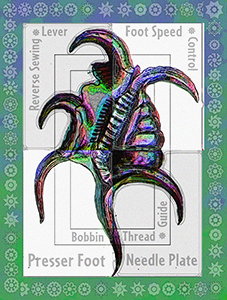
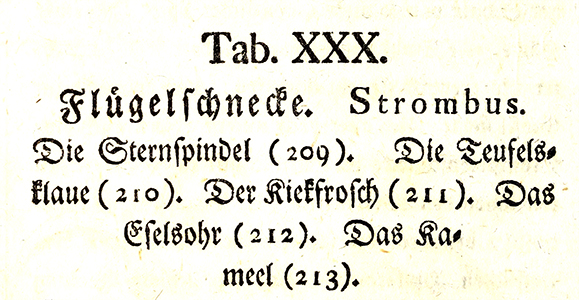
An illustration from an 1801 volume of Gottlieb Wilhelm's multivolume Unterhaltungen aus der Naturgeschichte (Link1), Translation: "Conversations on the Natural World." The creature is identified as #210 in the index at right -- but I can't quite read the old German blackletter font; Teufelsflaue?. Still, the series used the finest engravers from Augsburg, then the center of Europe's engraving trade. The words scattered about are just random words on my mind because I am learning how to use a sewing machine in order to enter the Plastic Club's Fiber, Fabric and Textiles show, with a deadline of March 29.
The font is CafeteriaBold (Link2), an early (1993) work by leading type designer Tobias Frere-Jones. Sadly, Frere-Jones is currently embroiled in a bitter business dispute with his partner in the "preeminent" type firm Hoeffler & Frere-Jones. The decorative dingbats around the edge are Cirkledingz(Link3) by Jakob Fischer, also known as Pizza Dude.
For maximum effect with my images, click on the image until it is full-size, which may be larger than your computer screen.
Sources:
Link1 archive.org/details/unterhaltungenau21802wilh
Link2 www.fontbureau.com/fonts/Cafeteria/
Link3 www.fonts2u.com/cirkledingz.font
Wednesday, March 19, 2014
Mishap at Royal Masquerade
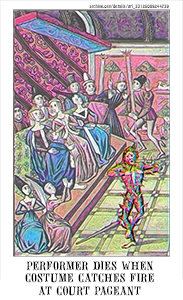
In 1393, the French court planned a piece of theatre to honor a court wedding. They took some linen body suits and used resinous pitch to cover them with hair-colored flax. "When they were all thus dressed, by having the coats sewed around them, they appeared like savages," explains the 1849 Chronicles of England, France, Spain and the Adjoining Countries (Link1), where this image appeared. Disaster followed when a member of the court grabbed a torch to more closely examine the "savages" -- and the pitch caught fire. By chance, the King, who was one of the "savages," survived.
The font is Bujardet Freres, by Michel Bujardet, who published his work under the name Match Fonts. Bujardet wrote: "This font is very precious to me, not only because that is one of the very first ones I created with Fontographer 3 (a while ago), but also because this character was used by my great uncles for their posters, at the 1900 Paris World Fair. Their company, Bujardet Frères, was selling enamel for the then flourishing furniture quarter, Saint Antoine, near Bastille."
For maximum effect with my images, click on the image until it is full-size, which may be larger than your computer screen.
Sources:
Link1 archive.org/details/gri_33125008244739
Tuesday, March 18, 2014
Dense Artistic Logjam, Big Decision
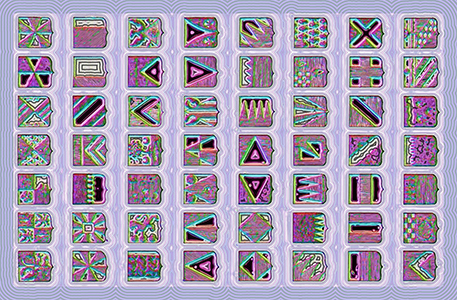
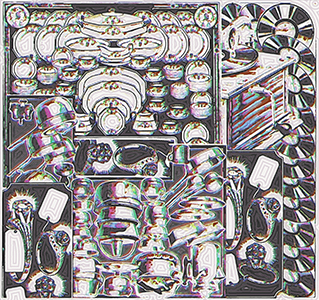
Very complicated (and huge) images with little compositional structure. Kind of stuck in an artistic rut, not sure what's going on. Also, making a big decision, whether or not to withdraw my candidacy for another 3-year term on the Co-op Board. Left image is heraldic shields from Diderot's 1762 Recueil de Planches, sur les Sciences, les Arts Libe´raux, et les Arts Mechaniques: avec leur Explication (Link1) Second image is composition of illustrations of sets of dinner dishes, records, and pans being advertised in a 1925 Photoplay movie magazine. (Link2)
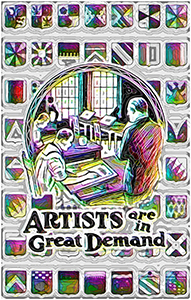
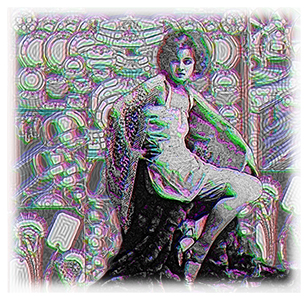
Later: Worked out compositional "solutions" to the two large, dense-pattern images, resizing them and adding clearly recognizable realistic elements from the same 1925 issue of Photoplay which produced the right-hand image: left, an advertisement for the home study art school that produced Charles Schulz and Mort Walker, and right, a young lingerie model, showing off "something new in glove silk underwear," specifically a vest and knickers.
For maximum effect with my images, click on the image until it is full-size, which may be larger than your computer screen.
Sources:
Link1 https://archive.org/details/RecueildeplanchIDide
Link2 archive.org/details/photoplayvolume22425chic
Saturday, March 22, 2014
Children Waiting to Cross Street & Extinct Animal
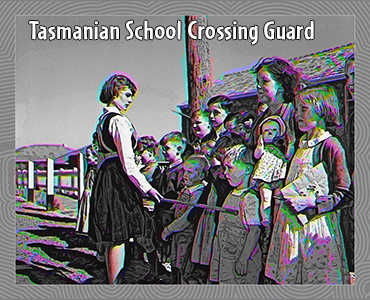
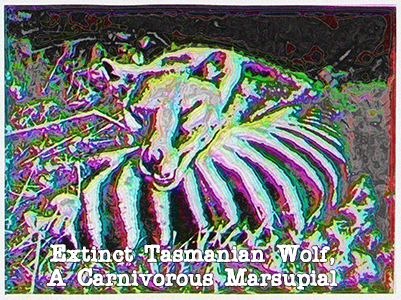
There's a new public archive on the Flickr Commons: from the Australian island-state of Tasmania. Here, in a 1951 photo (Link1) used as teaching aide, a school crossing guard uses a long stick to hold back young children before they cross a road. The guard looks like an older schoolgirl; indeed in my youth, the older children were given safety patrol duties. Nowadays, around here, safety patrol guards are more likely to be paid adults wearing brightly colored vests. In this photo, the crossing guard wears the same white safety patrol belt that I wore. It reminds me of one of the most unpleasant experiences of my teaching days. A teacher fell ill and I was ordered to take over a class of second-graders for dismissal. One of the boys came up to me and held out a white belt and said he had to do safety patrol at the corner. I told him "No, sixth-graders do safety patrol, not second-graders," and I refused to let him leave. He cried and fought me. It turns out that he was right, his sixth-grade brother had entrusted him with the job. Always regretted that situation...
In other news, I have withdrawn my candidacy for a second three-yeadsr term on the Co-op Board of Directors.
Meanwhile, another image from Tasmania: the extinct wolf, last sighted in 1936 (Link2). Perhaps the wolf is eying the young safety patrol girl. Fonts are, respectively, CafeteriaBold and the 1998 Chonker font by Aileen Lau.
For maximum effect with my images, click on the image until it is full-size, which may be larger than your computer screen.
Sources:
Link1 www.flickr.com/photos/tasmanianarchiveandheritageoffice/6980357040/
Link2www.flickr.com/photos/tasmanianarchiveandheritageoffice/7291813480
Tuesday, March 25, 2014
Democratic Legitimacy: On Sale by GOP
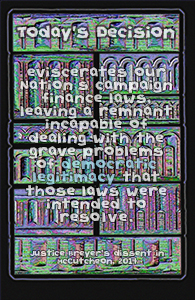
A political message, a quote from Justice Steven Breyer slamming the decision by the five Republican Supreme Court Justices, removing limits from campaign finance laws -- based on the argument that well-funded corporate propaganda campaigns are "free speech." The quote is placed over another composition of wooden decorative carvings from the trade catalog The Book of Carved Wood Decoration by Klise Manufacturing (Link1). The font is Cutting Corners by the prolific Aileen Lau.
For maximum effect with my images, click on the image until it is full-size, which may be larger than your computer screen.
Sources:
Link1 archive.org/details/KliseManufacturingCoIncThebookofcarvedwooddecor0001
Thursday, April 3, 2014
Peter Mattheisen
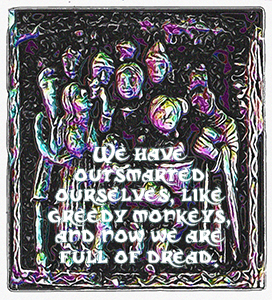
A quote from well-connected author and environmentalist Peter Mattheisen, who just died at the age of 86, after a year-long fight against leukemia. The words are from his book Snow Leopard. They are superimposed on a picture that appeared in the 1902 La Colonna del Cereo Pasquale di Gaeta: Contributo alla Storia dell'arte Medioevale (Link1). It is one in a series depicting the life of the Catholic saint Erasmus. From my weak grasp of Italian, I gather the picture is of either a Baptism or an Exorcism. (For a grisly depiction of the later martyrdom of Erasmus, allegedly by Arian heretics, see here). The font is Dark Crystal Script by Dennis Ludlow, which is based on the title script used in Jim Henson's animated movie, The Dark Crystal.
For maximum effect with my images, click on the image until it is full-size, which may be larger than your computer screen.
Sources:
Link1 archive.org/details/gri_33125013853862
Sunday, April 6, 2014
19th Century Enthusiasm for Tobacco II
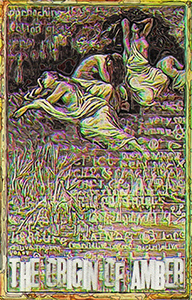
An illustration from an 1889 issue of the general-interest magazine Cope's Smoke Room (Link1), published by Cope Brothers, a Liverpool-based tobacco company that operated from 1848 to 1952. It is an illustration for an article on The Origin of Amber. The engraving illustrates the Greek legend in which young Phaethon lost control of the horses pulling the sun chariot and was killed by Zeus with a thunderbolt when the runaway sun threatened to burn up the earth. Phaethon's sisters "found [his] grave, over which they ceaselessly wept, unable to tear themselves away. At last the sisters took root in the ground, bark rapidly covered their bodies, their arms became boughs, and their hair leaves, and they were entirely changed into trees. Still the tears continued to flow, and these, hardened by the sun, became amber..." Overlaid on the engraving is a page from the classroom doodles of typographer Tom Murphy from his old web page. The font used here is >Metal Block Tango by Xerographer Fonts.
For maximum effect with my images, click on the image until it is full-size, which may be larger than your computer screen.
Sources:
Link1 archive.org/details/pipeoftobaccowit00blan
Monday, April 7, 2014
Notes on the Road II
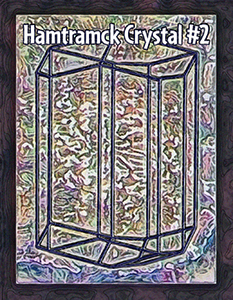

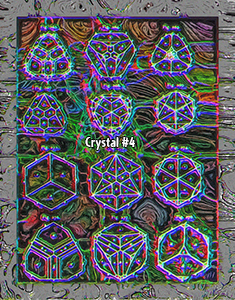
Settling in for first days in Hamtramck, more experimental crystal pictures from German crystal book (Linki1).
For maximum effect with my images, click on the image until it is full-size, which may be larger than your computer screen.
Sources:
Link1 archive.org/details/atlasderkrystalltaf09gold
Saturday, April 19, 2014
Notes on the Road I

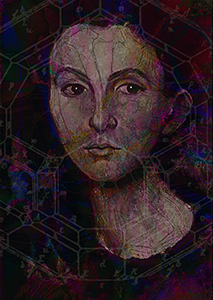
Luna Pier is a tiny city (pop. 1500) on Lake Erie, right off I-75 in Michigan. Ran across the city during my teenage wanderings from suburban Detroit and it has always fascinated me, for its brave little pier curving out onto the lake and its neat no-millionaire look. Here is an image memorializing this personally remarkable event: staying overnight, sipping a beer, in a beachfront town that has exerted a curious hold on me for 50 years. The font is Tobias Frere-Jones' Cafeteria Bold. The central image is a diagram of a crystal appearing in the 1913 Atlas der Krystallformen (Link1). Next to it, done at the same Luna Pier session, is one of the "art cards" showing the work of pre-Holocaust Jewish painters, from the collection of Otto Schneid at the University of Toronto. The painting of a woman's face is by T. Dikmen. The same crystalline structure shown in the first image is superimposed on this image, as well as two levels of fractalization (Link2).
For maximum effect with my images, click on the image until it is full-size, which may be larger than your computer screen.
Sources:
Link1 archive.org/details/atlasderkrystalltaf09gold
Link2 archive.org/details/ottoschneid15_5
Friday, April 18, 2014
Rain-Delay Doodles
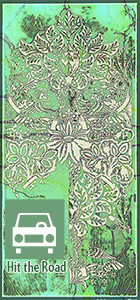
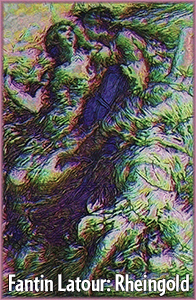
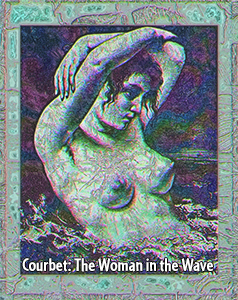
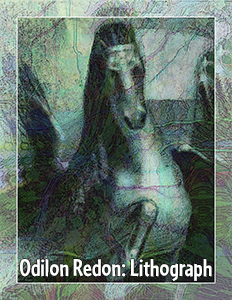
Various doodles, using fractal overlay on top of pictures from the 1904 Entwickelungsgeschichte der Modernen Kunst : Vergleichende Betrachtung der Bildenen Ku¨nste, als Beitrag zu Einer Neuen Aesthetik (Link1). From left: a William Morris print, a Latour engraving of the Rhine Maidens, a Courbet painting, and a Redon lithograph.
For maximum effect with my images, click on the image until it is full-size, which may be larger than your computer screen.
Sources:
Link1 archive.org/details/gri_33125012075673
Tuesday, April 15, 2014
Pattern of Rock Circles
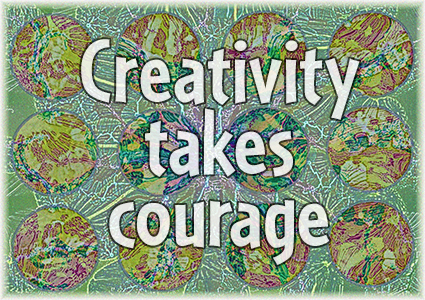
A quote from artist Henri Matisse, displayed against a matrix of rock samples, from the 1918 Encyclopedia Americana (Link1). Again, use of fractal filter to add texture to the image.
For maximum effect with my images, click on the image until it is full-size, which may be larger than your computer screen.
Sources:
Link1 archive.org/details/encyclopediaame34unkngoog
Monday, April 14, 2014
Change in Attitude
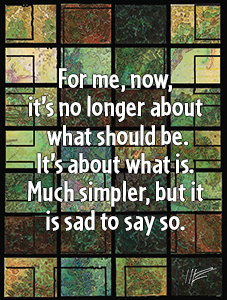
A personal thought, in Cafeteria Bold font, displayed against a pattern of linoleum samples from the 1930 Zenitherm for Walls and Floors trade catalog (Link1). I also used two online filters (Poster Edges and Fractalize) to add texture.
For maximum effect with my images, click on the image until it is full-size, which may be larger than your computer screen.
Sources:
Link1 archive.org/details/ZenithermForWallsAndFloors
Monday, April 14
, 2014
Encyclopedic Rabbits
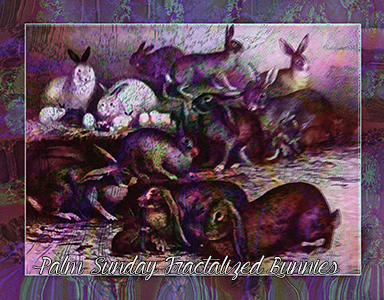
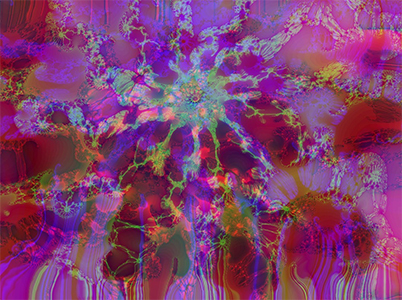
From the 1918 Encyclopedia Americana (Link1), an illustration that accompanied the article on Rabbits, which reveals that some rabbits have ears that are 24 inches long. The font is Young and Beautiful, a new font by Misti Hammer.
I used on online filter on a reduced-size image to get fractal color effect (on right). You can barely make out the huddled black shapes of the rabbits. Not sure I'm pleased with this use of the fractal effect, but am intrigued by the possibilities.
For maximum effect with my images, click on the image until it is full-size, which may be larger than your computer screen.
Sources:
Link1 archive.org/details/encyclopediaame34unkngoog
Sunday, April 13, 2014
Springtime Frolics in Hadrian Legend
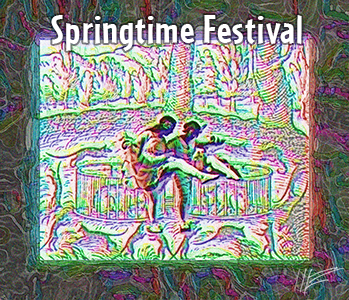
From a 1921 newspaper photo of a two girls dancing in a Springtime Festival in France (Link1) superimposed on an engraving from the 1565 Hadriani Iunii medici Emblemat
. Arnoldum Rosenbergum (Link2).
For maximum effect with my images, click on the image until it is full-size, which may be larger than your computer screen.
Sources:
Link1 gallica.bnf.fr/ark:/12148/btv1b53054894p
Link2 archive.org/details/81285178.4931.emory.edu
Thursday, April 24, 2014
Fashionable Parisian Women
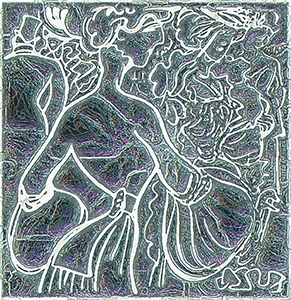
A small illustration from the 1906 L'Oncle de l'Europe (Link1), a collection of cartoons and illustrations depicting the era of Edward VII. This illustration shows a collection of fashionable French ladies, painted and corsetted, "elegant all the way to their manicured nails." No text, just an experiment with a different style -- and mood.
For maximum effect with my images, click on the image until it is full-size, which may be larger than your computer screen.
Sources:
Link1 archive.org/details/gri_33125009789161
Monday, April 28, 2014
Anatomy on Interior
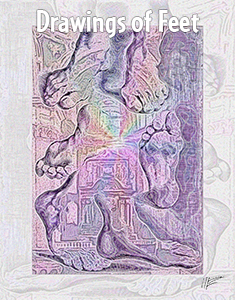
Engravings of some drawings of feet from a 17th century Scvola Perfetta per Imparare a Disegnare Tutto il Corpo Humano (Link1) collection of examples of anatomy, including some by Michelangelo. (Unfortunately, it is hard to figure out which print goes with which artist.) The image is superimposed on an engraving of a Salzburg courtyard from the 1889 Geschichte des Barockstiles und des Rococo in Deutschland (Link2).
For maximum effect with my images, click on the image until it is full-size, which may be larger than your computer screen.
Sources:
Link1 archive.org/details/gri_33125009488004
Link2 archive.org/details/gri_33125010501225
Sunday, May 4, 2014
Dancer at Rest
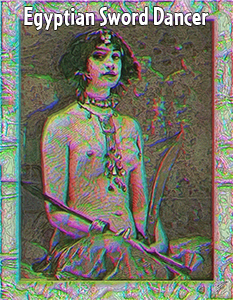
A painting by the 19th century German painter Bruno Piglhein, showing a young Egyptian sword dancer. It is from the 1891 Die Internationale Kunstausstellung zu Berlin [International Art Exhibition in Berlin] (Link1). Wikipedia tells us that after some initial successes, Piglhein "was not very successful. At the suggestion of his agent, he turned to pastel portraits of women; favoring Spanish dancers, pierrettes [clowns] and belles-of-the- ball with low décolletage. He then came into fashion, but also found himself being criticized as a bad moral influence and a 'courtesan painter.'" Besides her obvious physical attributes, I like the posture, poise, and cool exhibited by the sitter. The Sword Dance and Sword Dancer have a long history and live today in anime cartoons and imaginative literature.
For maximum effect with my images, click on the image until it is full-size, which may be larger than your computer screen.
Sources:
Link1 archive.org/details/gri_33125001104617
Saturday, May 3, 2014
Little Book II: Colour=>B/W=>Fractal Color
Another experiment in folded book format. The images are sized correctly, but the second row should be upside down and appear before the first row in the final folding template.
 |
From Colour photography : and other recent developments of the art of the camera (1908)
Taking the black-and-white illustrations from a 1908 book on colour photography, and adding digital color to them using the fractal filter at https://gmicol.greyc.fr/ |
 |
 |
 |
 |
Source: https://archive.org/details/colourphotograph00holm_0 |
Little Books 1
In the week since my return, I have been somewhat confused as to what I'm doing. One thing I've been doing does not translate well into a web page. I've been making simple 8-page folded books, as shown here and in this YouTube video. A PDF of a draft of one these books, What Artists See in Mirrors, is here. What follows is an attempt to translate this into a web format.
 |
An artist working for a furniture company is told to create an image of a room for an upcoming catalog. In that imaginary room, there may be a dressing table, a chair, a lamp, perhaps a fashionable lady -- as in the cover. Painting such things does not present an obstacle for a trained commercial illustrator. But also in that imaginary room, the client wants the artist to show a Mirror of a certain shape. Hmm. How will the artist fill in that blank mirror shape? The viewer expects to see a visual reflection of the room's background there. But imaginary rooms do not cast reflections! The artist must imagine a background -- wall, curtains, windows -- that doesn't exist. Certainly not reality -- we're already several steps removed from ordinary reality -- but more a plausible imitation of the visual effects of a reality when not too closely examined. |
 |
 |
These examples are from a 1928 catalog of steel bathroom cabinets from the Miami Cabinet Company, a public domain document available at archive.org/details/MiamiSteelBathroomAndIroningBoardCabinets.
|
 |
 |
Ravished by RINSO Suds
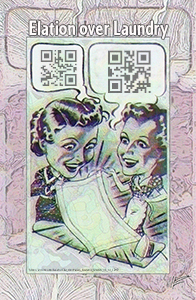
An advertisement from a 1939 Australian Women's Weekly (Link1), showing two cartoon women in joy because whites are whiter, "colours brighter, silks and woollens like new." Besides, the copywriter says, RINSO is "kind to your hands." The machine font in the dialog balloons is Quick Response (QR) code.
This will be the last philly-bob.net image until early June, as I leave soon on a trip.
For maximum effect with my images, click on the image until it is full-size, which may be larger than your computer screen.
Sources:
Link1 archive.org/details/The_Australian_Womens_Weekly_02_12_1939
Saturday, May 17, 2014
Illustration from Phrenology Text
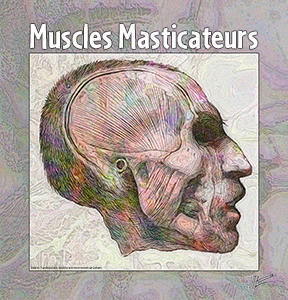
During the 19th century, a lot of academics advocated various versions of phrenology, a theory of human types that was usually racist and is now discredited. This is from the 1911 French book Physionomie et caractère, essai de physiognomonie scientifique by Paul Hartenberg. The theory says that you can read character from facial configuration. Anyway, this is a skillfully done chart from that book showing the muscles involved in chewing. Credit where credit is due -- this ink drawing was done by accomplished illustrator Edouard Cuyer. [Note: this is in Plastic Club directory.]
Fip-off alert: Amazon is selling a printed version of this book for 20 euros, when you can download it for free. Not working much on this webpage because I'm facing a travel deadline. I will probably travel without this computer, just with IPad.
For maximum effect with my images, click on the image until it is full-size, which may be larger than your computer screen.
Sources:
Link1 archive.org/details/physionomieetcar00hart
Friday, May 16, 2014
The Writing Desk
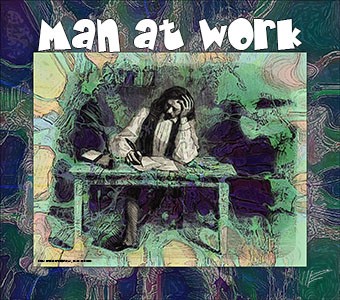
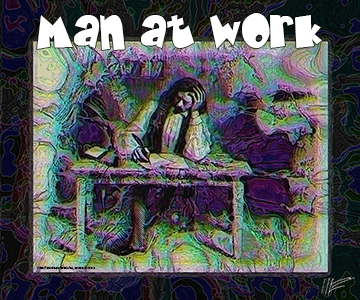
From the 1840 book Les Etrangers a Paris [Strangers in Paris] (Link1), a man sits at his writing desk with pen and paper. The font is Baby-Kruffy by the Font Brothers. This piece marks a major change in my working technique: for a long time I have used a layer created by Gimp's "Gradient RGB" filter to add bright primary colors. But sometimes I found the result a little nauseating, as shown in the right hand image -- especially when they are printed. In the right hand image, I removed that RGB step. My method of producing fractalized color now supplies plenty of color for the black-and-white images I so often work with.
For maximum effect with my images, click on the image until it is full-size, which may be larger than your computer screen.
Sources:
Link1 archive.org/details/gri_33125008713295
Saturday, May 10, 2014
Anatomy Lesson: The Nose
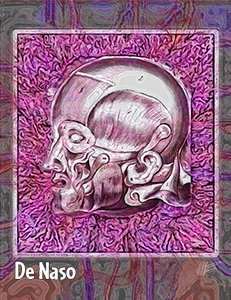
Back from Greece. Will I continue do these public domain art projects? I don't know. This one, for instance, took an hour to select original images and then another 2.5 hours to do this image. Is it worth it? One takeaway from time spent with fine artists on painting holiday in Greece: they had serious doubts about my use of text, so I am experimenting a little bit.
Anyway, this is an illustration from Thomas Bartholini's 1686 Anatome ex omnium veterum recentiorumque observationibus inprimis institutionibus (Link1) showing the nasal cavities.
For maximum effect with my images, click on the image until it is full-size, which may be larger than your computer screen.
Sources:
Link1 archive.org/details/gri_33125010543912
Friday, June 6, 2014
A Lady and her Tweaker
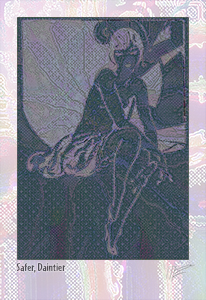
From the June, 1927 issue of the theatrical publication Variety, an image of a young woman used to advertise The Tweaker, a scissor-like device for "theatrical women," used to remove unwanted hair from arms and legs. An informative retrospective look at the product appears on the Glamourologist website. Nowadays, the word has different meanings.
For maximum effect with my images, click on the image until it is full-size, which may be larger than your computer screen.
Sources:
Link1: archive.org/details/variety87-1927-06
Friday, June 21, 2014
Photographic Proof of Spirits
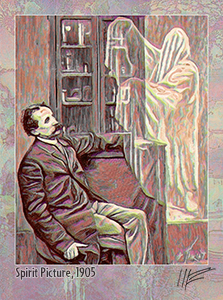
From the 1905 Photographic Amusements : including a description of a number of novel effects obtainable with the camera, a discussion of the "scientific" photographs of the mid 19th century study centered on the study of Spiritualism and Ghosts. Turns out, the author explains, this image was a product of re-using glass in the photographic process: a double exposure. It is hard to believe that anyone could have taken this seriously.
For maximum effect with my images, click on the image until it is full-size, which may be larger than your computer screen.
Sources:
Link1 archive.org/details/photographicamus00wood_0
Friday, June 21, 2014
Plastic Club Portraits
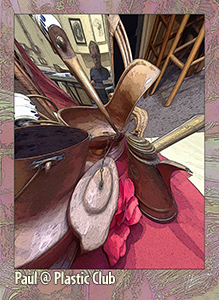
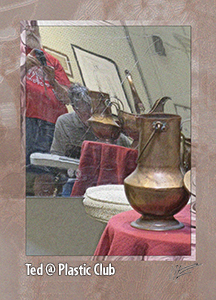
Every Thursday morning, I go to the still life workshop at Philadelphia's Plastic Club. Everybody does their own thing. Many work from a still life set up by the teacher. I put a mirror behind the still life and grab reflected portraits of my fellow students.
And here's two older ones:
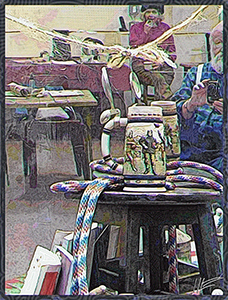
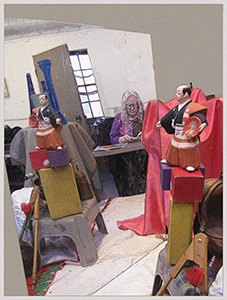
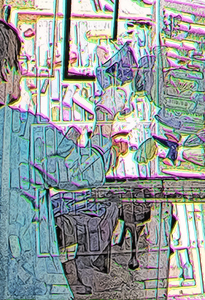
Announcement
I'm going to learn how to write apps/programs for the Android operating system. Right now, I have an Android phone and I intend to get an Android tablet. Since I have some programming background in the language Python, I hope to use the free program QPython. You can follow my progress Android Programming Project. May mark a decline in time spent on art and co-op politics.
Devalued Concepts
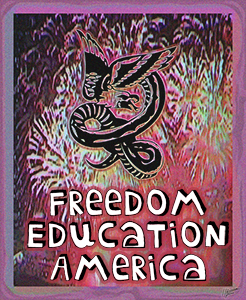
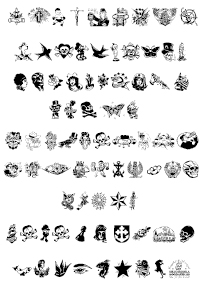
In today's America, two ideals that I believed my whole life in have been devalued. Now, Freedom means economic freedom, the right of those with money to do what they want with it, and Education is a method of creating a class of technically-skilled workers, uncritical and indebted, easily controlled. The background image is Janice's snapshot of fireworks. The foreground is one of the "Old School Tattoo" dingbats by skillful but bad-boy Spanish type-designer named Woodcutter. The tattoo shows a chimerical combination of an eagle and a snake. The full set of Woodcutter's Old School Tattoo #1 dingbat font is on the right. Top row is numbers, next three rows are small letters, next three rows are capitals, and final row is various punctuation. Note the antisemitic, pro-Nazi symbol in the center of the upper row, showing a pretty SS-guard holding a Jewish head on a dagger; I looked the image up online and it's a 1950's criminal tattoo from Stalin's Gulag prison camps. (I don't find other Nazi imagery in Woodcutter's work, but I told you Woodcutter was a bad boy -- not given to political correctness.) The text font is Woodcutter's Federico font.
Source: NA
July 4, 2014
Experiment II
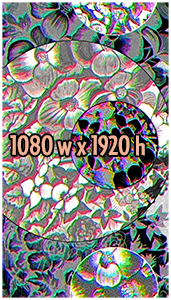
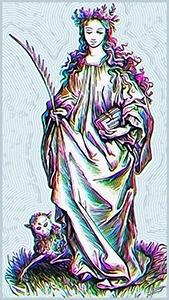
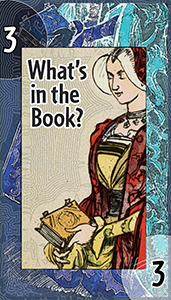
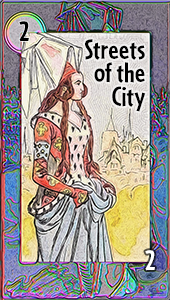
Worked a detail from the Spring 1889 Whitnall's illustrated catalogue of seeds, plants, trees, shrubs, vines, tools, etc. into the 1080 pixel wide by 1920 pixel high dimensions of Android Tab 5 phone.
Next to that is a picture of St. Agnes from the 1871 A handbook of legendary and mythological art.
Next, two cards from a draft of a Tarot Deck I'm thinking of making -- image is from the 1891 Mesdames nos ai?eules : dix siecles d'elegances, hard to translate, something like Our Grandmothers: Ten Centuries of Elegance. The picture illustrates a 15th century costume.
After two weeks, some slim signs of progress in my Android Programming Project -- learning how to write apps for Android phones and tablets. Delays and confusion in this process sent me into a deep depression. Sitting around in my underwear until 3 PM -- fleeing to the juvenile bad-boy websites -- wondering Gee, maybe I'm not smart anymore. (In my memory, that sort of conflicting-source highly-complex beta-version technical challenge used to be easy.)
This image is also a PNG file, not a JPG.
Source:
Link1: archive.org/details/whitnallsillustr1889cbwh
Link2: archive.org/details/handbookoflegend00wate_0
Link3: archive.org/details/mesdamesnosaieul00robi_0
June 28-30, 2014
Experiment
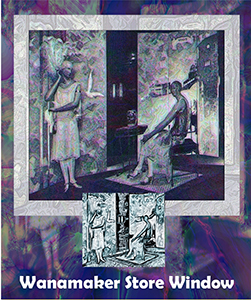
Switched from Photoshop to InDesign for this image. Suggests a different style.
June 27, 2014
Window
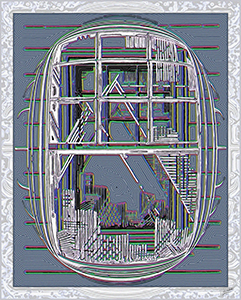
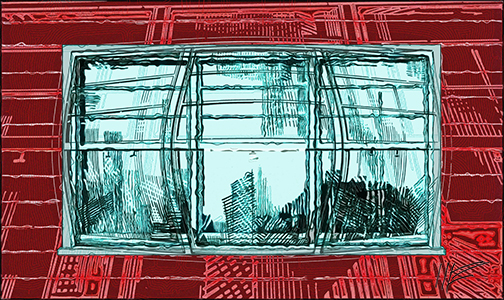
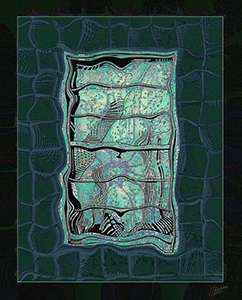
Variations of ink drawings of window installations from an undated aluminum window catalog. Slow progress because Chromebook arrived, and I've been suffering through yet another slow ascent up a learning curve. Last one, finished July 16.
Source:
Link1:archive.org/details/AdlakeDoubleHungAluminumWindow_544
July 9-16, 2014
Another Combination
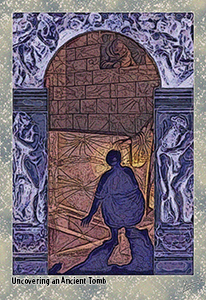
From the 1804 Views in Palestine, from the original drawings of Luigi Mayer (Link 1), a picture showing the discovery of the tomb of Joseph of Arimethea. The discovery scene, with the explorer crouched before the empty tomb, is framed in a set of columns and arches by Eugene Delacroix from a 1902 book on the works of Eugene Delacroix (Link 2). Finally, barely visible in the background of the tomb scene, a diagram from the 1911 Singer Instructions for Art Embroidery (Link 3).
Source:
Link 1: archive.org/details/gri_33125008694941
Link 2: archive.org/details/eugenedelacroix00tour
Link 3: archive.org/details/singerinstructio00sing
July 25, 2014
Fashions of A Time
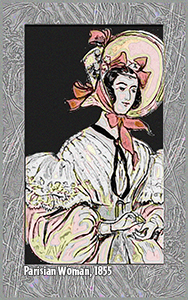
From the 1891 Mesdames Nos Ai?eules: Dix Siecles D'Elegances (My translation: "Our Good-Looking Ancestors: Ten Centuries of Elegance"), a woman dressed in the fashion of Paris in 1855.
Source:
Link 1: archive.org/details/brothersmarisjam00thom
Link 2: archive.org/details/gri_33125012075616
August 5, 2014
Two Women of the European Church
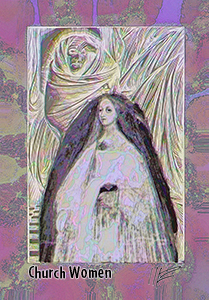
Bottom image is a painting by Matthew Maris titled "Bride of the Church," from the 1907 catalog of the works of the three Maris Brothers (Link1). Below that, with a much longer story, is an image from the 1904 Entwickelungsgeschichte der Modernen Kunst: Vergleichende Betrachtung der Bildenen Ku¨nste, als Beitrag zu einer Neuen Aesthetik (Link2), showing George Minnes' illustration of a scene from Maeterlinck's opera Sister Beatrice, which tells a fantastic story, worth quoting at some length (from this summary:
"Sister Beatrice is about to elope from the convent with Bellidor, and is praying before the Virgin's image. She hears the horses of her lover -- he comes in with costly garments and jewels, and while she has swooned, protesting against his wild embraces, he takes off her veil and mantle. ... As the sun shines into the corridor, the Virgin stirs and comes to life and puts on the dress of Beatrice and ...the Virgin assumes the likeness and duties of Beatrice.... Twenty-five years later, while the last strokes of the matin-bell are heard, the aged Sister Beatrice enters, worn out and in rags, and falls at the feet of the statue, though she has forgotten how to pray. Her mantle and veil, lying where she left them, she puts on. [She] tells how Bellidor ceased to love her after three months, and how she became a prostitute, and how she killed her last child. The Abbess tries to stop her mouth in vain, and tells her she is most holy. They believe that Beatrice has never left them... She cannot understand, but supposes that an angel has taught them to know to pardon all. She sinks back exhausted, and the nuns fall on their knees around the bed."
Source:
Link 1: archive.org/details/brothersmarisjam00thom
Link 2: archive.org/details/gri_33125012075616
August 4, 2014
Private Graphic Language
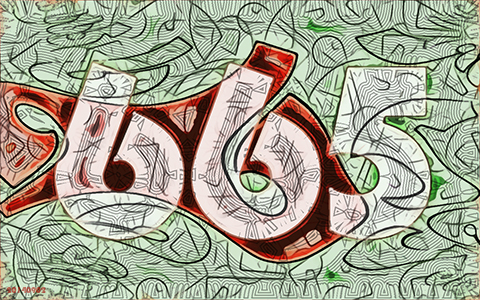
Coded message to the universe. Font for 665 is Bauhaus 93. Color scheme come from the 1910 Agate House Paints (Link1),
with Pea Green in the background and Bright Red in foreground..
Source:
Link1: archive.org/details/AgateHousePaints
September 2, 2014
Mystery Image
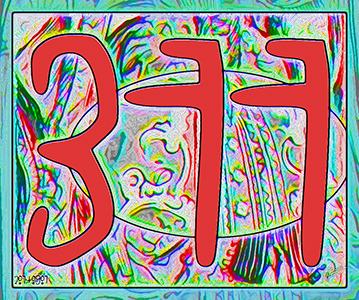
Private image, means something to me, retreating into my private world. Text is 377 and the font is American Horror Story.
The background image is from the 1891 Mesdames Nos Ai?eules: Dix Siecles D'Elegances.
Source:
Link1: archive.org/details/mesdamesnosaieul00robi_0
September 1, 2014
Coin Flip
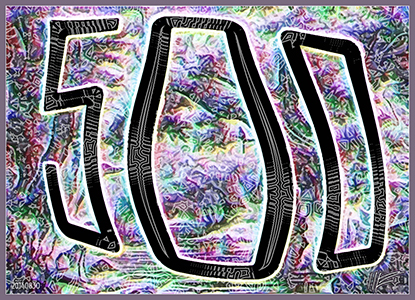
A lot of changes in my thinking recently, much of it reflected in my other website, zer0sum.net. It's been a rocky road, starting out in a deep 5-day depression. But I came out of the depression with a clear plan, and it's been absorbing. In my programming project, there was one task that I thought would take me five minutes, it ended up taking five days! I just figured it out Friday morning -- I used a reserved word as a variable. The quest to find a solution led me to post a query on an intimidating smart-techy website, www.stackoverflow.com. Anyway, this image represents a number from that programming project, distorted and set against a pastoral image from the 1850 Le Langage des F leurs (Link 1).
Source:
Link 1:archive.org/details/lelangagedesfleu00cort
August 30, 2014
400 on Anatomy
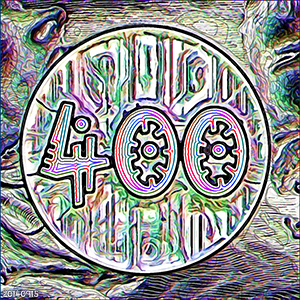
Material behind the digits is a rather grisly illustration from the 1804 Engravings of the Bones, Muscles, and Joints, somewhat obscured for the reader's sake. A cadaver's nose is visible in the upper left corner. The font is Jokerman.
Source:
Link: archive.org/details/56620180R.nlm.nih.gov
September 15, 2014
Sorority Sisters in White Hoisting Glasses
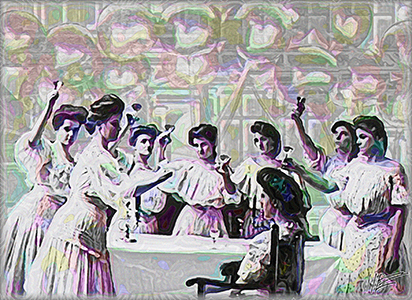
Going back to the Miami University collection of the Frank Snyder Studio photos on Flickr Commons, a 1905 photograph entitled A Toast to the Bride (Link1), placed against a texture composed of two sources: (1) a drawing of building fronts from the Getty Research Institute's 1582 Architectvra, Oder, Bauung der Antiquen Suss dem Vitruuius (Link2) and a strand of grapes from a 1939 seed catalog (Link3).
For maximum effect with my images, click on the image until it is full-size, which may be larger than your computer screen.
Sources:
Link1 www.flickr.com/photos/muohio_digital_collections/3195497966/
Link2 archive.org/details/gri_33125009319167
Link1 archive.org/details/1939cataloglates1939bent
Friday, February 14, 2014
Toesies: Homage to Durer
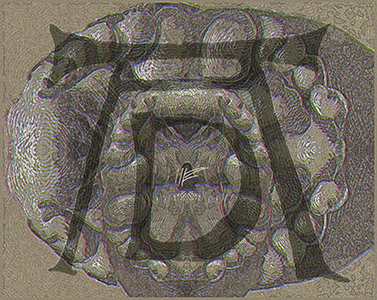
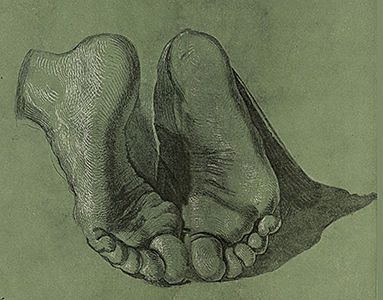
From the American Collection of the Internet Archive, the Getty Research Institute uploaded a scan of the 1892 Albrecht Du¨rer (Book1), a collection of prints and drawings by the master 16th century artist. Here, on the left, is my interpretation of the image on the right, a study on green paper of feet for a painting. Looking at Durer's work, I am reminded of the line from the Catholic Mass of my youth: Domine, Non Sum Dignus (Lord, I am not worthy). My digital manipulations, highlighting the exquisite line and shading of the toes, may be sacrilege on the work of a master, which is why I am highlighting Durer's monogram and centering my own signature in his. But then, such revision of old work goes with the territory of my public domain work...
For maximum effect with my images, click on the image until it is full-size, which may be larger than your computer screen.
Sources:
Link1 archive.org/details/albrechtdurer00spri
Thursday, February 13, 2014
Portrait of Two Women
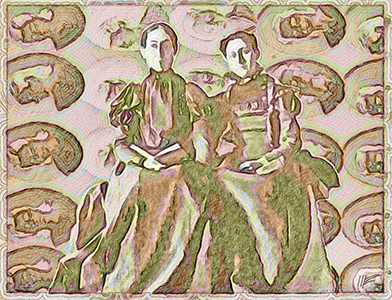
From the Miami University collection on Flickr Commons, an undated photograph (Link1) from the studio of Frank Snyder, probably early in his career, around 1900. It shows two women sitting in a parlor. The background is composite photo, also from Snyder's studio, called a "Ping Pong Portrait of Five Women" (Link2), dated approximately 1933. If you zoom in all the way, there is a curious effect in the "squiggles" in the background of the two women, in which the squiggles are different colors. I like the effect, but I'm not sure I remember how I did it!
For maximum effect with my images, click on the image until it is full-size, which may be larger than your computer screen.
Sources:
Link1 www.flickr.com/photos/muohio_digital_collections/3195529996/
Link1 www.flickr.com/photos/muohio_digital_collections/3195533598/
Wednesday, February 12, 2014
Young Women on Farm
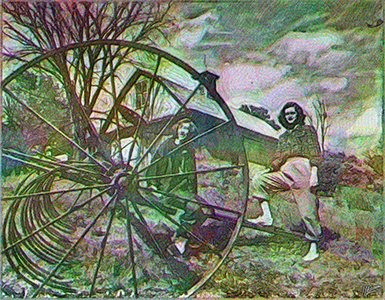
Another one from the new Miami University collection on Flickr Commons, a photograph (Link1) from the studio of Frank Snyder, a photographer who worked in Ohio from 1897 to 1955 -- mainly between 1900 and 1930 -- labeled simply Two Women with Farming Equipment. I like the women's casual, unglamorous look and the overall composition with the barn, tree, cloudy sky and mysterious farm implement (thresher?),
For maximum effect with my images, click on the image until it is full-size, which may be larger than your computer screen.
Sources:
Link1: www.flickr.com/photos/muohio_digital_collections/3196826486
Wednesday, February 12, 2014
Victorian Welcome
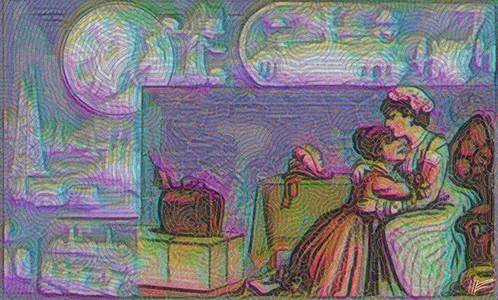
Also from Miami University of Ohio and its collection of VictorianTrade Cards, two cards combined in one image. One card (Link1) shows a map of Pennsylvania and illustrates various industries, the other card (Link2) from a company that makes a product called Welcome Soap, showing a recently-arrived young woman embracing her hostess. Marking my anxiety about possible snow disruption of my return trip from Florida to Philadelphia.
For maximum effect with my images, click on the image until it is full-size, which may be larger than your computer screen.
Sources:
Link1: www.flickr.com/photos/muohio_digital_collections/3092840825
Link2: www.flickr.com/photos/muohio_digital_collections/3093855650
Monday, February 10, 2014
Girls Dancing on May Day
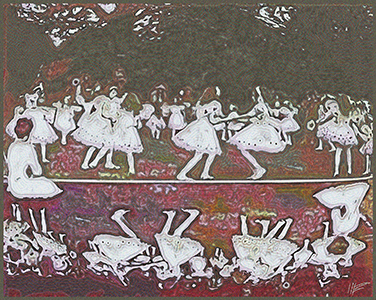
Turning to the Flickr Commons Collection from Miami University of Ohio, a 1912 photograph of May Day dancers at Ohio's McGuffey School. The school was presumably named after William McGuffey, originator of the McGuffey Readers. May Day has an unusual history, ranging from ancient pagan Spring ceremony to political/worker's holiday. When my wife worked at Bryn Mawr campus, the school had a beautiful May Day ceremony similar to this scene, with young women dressed in white dancing around a ribboned Maypole.
For maximum effect with my images, click on the image until it is full-size, which may be larger than your computer screen.
Sources:
Link1: www.flickr.com/photos/muohio_digital_collections/3200537400/
Sunday, February 9, 2014
Another A.G.B. Re-Mix
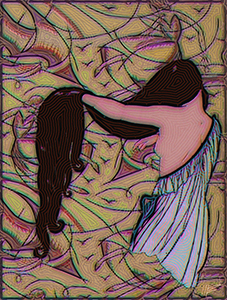
From the August 1923 issue of the French Art Deco publication Art Gout Beaute (Link1), an advertising illustration (for something called Henne Tinxol Hennextre), placed against a breezy textile design.from the July 1923 issue (Link2) of the same magazine.
For maximum effect with my images, click on the image until it is full-size, which may be larger than your computer screen.
Sources:
Link1 archive.org/details/artgoutaug1923unse
Link2 archive.org/details/artgoutjul1923unse
Sunday, February 16, 2014
The Coral Necklace Empatterned
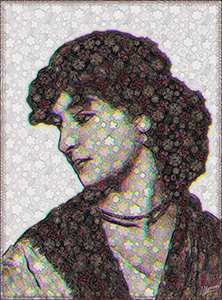
A reproduction of the painting The Coral Necklace by Eugene de Blaas used on the cover of the Sept. 1889 Dominion Illustrated (Link1) from Canada. The "female face divine" is then empatterned (a new term I am inventing), subdivided into various levels of brightness, and then superimposed on a crepe de chine pattern from a 1928 edition of the French Art Deco publication Art Gout Beaute (Link2). I will be experimenting with this technique for a while -- transferring a black and white image onto a textured pattern.
For maximum effect with my images, click on the image until it is full-size, which may be larger than your computer screen.
Sources:
Link1 archive.org/details/dominion_illustrated_sept1889
Link2 archive.org/details/artgoutaug00unse
Tuesday, February 18, 2014
South American Man Reimagined as Flowers
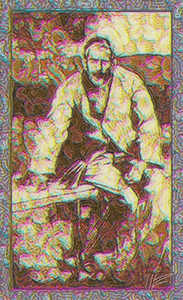
An image from the 1914 La Ciudad de los Locos: Aventuras de Tartarín Moreira (Link1), a book of stories set in South America. It is set against the floral pattern on the endpaper of another book, the 1930 La Mujer Moderna (Link2). Both books were uploaded by the University of Toronto to the Canadian library section of the Internet Archive. The resulting image represents a major technical breakthrough for me -- using a Photoshop action I wrote that divides an image into shadow, middletone, and highlight selections, then taking a background image (like the floral pattern) and using those selections to recolor certain sections.
For maximum effect with my images, click on the image until it is full-size, which may be larger than your computer screen.
Sources:
Link1 archive.org/details/laciudaddelosloc00soiz
Link2 archive.org/details/lamujermoderna00mart
Monday, February 17, 2014
Shell and Carpenter's Plan
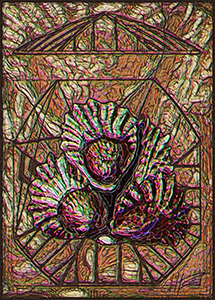
Moving on to the Internet Archive collections of Building and Biological Diversity, and moving away from the "empatterning" experiments, a composition of two images: (1) a seashell from the 1847 Thesaurus Conchyliorum, or, Monographs of genera of shells (Link1) and (2) a plan for an octogonal wooden roof from the 1938 Modern Carpentry: A Practical Manual (Link2). The background is a highly-enlarged detail of the seashell.
For maximum effect with my images, click on the image until it is full-size, which may be larger than your computer screen.
Sources:
Link1 archive.org/details/thesaurusconchy11847sowe
Link2 archive.org/details/FredTHodgsonModernCarpentryAPracticalManual
Thursday, February 20, 2014
Empatterned Diesel Part
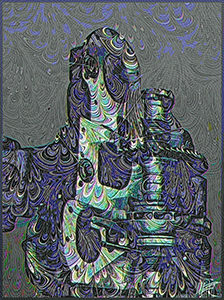
In the foreground, a cutaway view of a turbocharger from the 1944 Army technical manual TM 55-271: Operation of Railroads: Diesel-Electric Locomotives (Link1). The industrial drawing is empatterned with the design from marblized paper used to bind the 1967 The Prints and Photographs collection of the National Library of Medicine (Link2). I rotated the machine part 90-degrees, to make it look like a hypermodern sci-fi building in a storm, but I'm not sure it worked. Going through a personal period of creative angst and dissatisfaction.
For maximum effect with my images, click on the image until it is full-size, which may be larger than your computer screen.
Sources:
Link1 archive.org/details/TM55-271
Link2 archive.org/details/0114054.nlm.nih.gov
Monday, February 24, 2014
Eros and Time
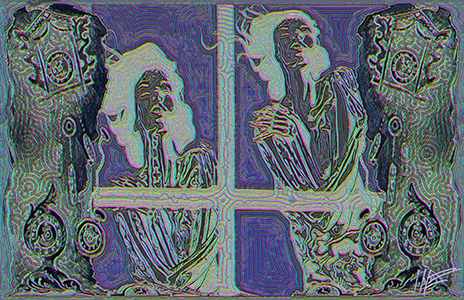
A collage of two illustrations from the magazine Pan, Link1, which is a Polish general interest magazine. In the center, a curious composition in which two stylized female figures appear in what seems to be a window frame. This image is used to illustrate an article on (I think) Erotica in Poland. On both right and left side is a image of clocks that was used to illustrate a poem.
For maximum effect with my images, click on the image until it is full-size, which may be larger than your computer screen.
Sources:
Link1: archive.org/details/MagazynPan71988
Kama Sutra Marco Polo
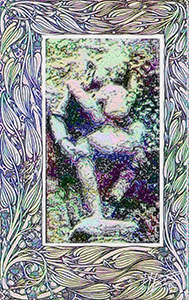
The frame was used for the ornate title page of a 1929 reprint of the 13th century The Travels of Marco Polo the Venetian (Link1), with an introduction by John Masefield, from the University of Toronto Library. Polo was Indiana Jones before his time. Inside the frame, a rather fuzzy photograph of a statue of a man and woman coupling, him standing, her with legs wrapped around him, from the famous carvings in Hyperabad, India, used as an illustration for an edition of The Kama Sutra of Vatsyayana, dated sometime between 1883 and 1925. I remembered to include my signature logo, this time. If you zoom in to look at it, you'll see it's right next to the original engraver's signature.
For maximum effect with my images, click on the image until it is full-size, which may be larger than your computer screen.
Sources:
Link1: archive.org/details/marcopolo00polouoft
Link2: archive.org/details/kamasutraofvatsy00vatsuoft
Sunday, January 26, 2014
Leather Fetish
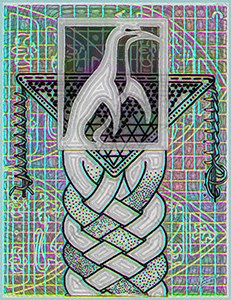
An assemblage of illustrations from a single book, the 1946 Leathercraft for Amateurs (Link`). In the background, instructions for enlarging a heraldic design using graph paper. In the top foreground, a pelican emblem, below that a decorative triangle, with two examples of leather stitching hanging techniques from the triangle's vertices; and finally, below the pelican, a diagram explaining how to make a five-strand braid. (In my boating days, one of the most difficult tasks was splicing a braided rope around a metal eye.)
...Packing for Florida trip.
For maximum effect with my images, click on the image until it is full-size, which may be larger than your computer screen.
Sources:
Link1: archive.org/details/leathercraftfora006855mbp
WWI Naval Bombardment
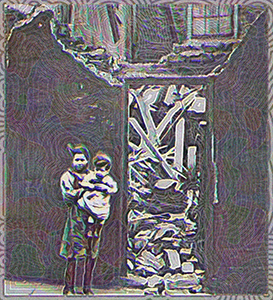
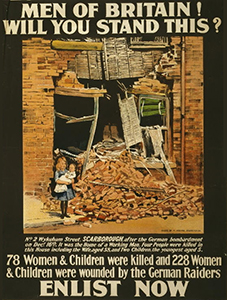
In December, 1914, ships of the Imperial German Navy shelled some English coastal communities. From the Flickr Commons archive of one of those towns, Hartlepool, a photo (Link1) of a little girl holding a child stands next to a shelled building. Next to that is a poster apparently influenced by that photo.
For maximum effect with my images, click on the image until it is full-size, which may be larger than your computer screen.
Sources:
Link1: www.flickr.com/photos/hartlepool_museum/5633991483/
Link2: en.wikipedia.org/wiki/File:Scarborough,_North_Yorkshire_-_WWI_poster.jpg
Friday, January 24, 2014
Lighthouse Fixture II
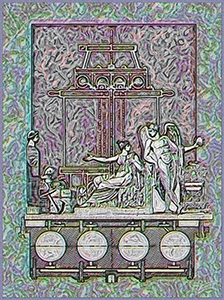
Another image from the École Nationale des Ponts et Chaussées. It shows a classical-style French engraving of some winged god, casually leaning against a chair, holding a laurel wreath talking with a Grecian-garbed goddess gesturing at symbolic tools and implements of industry, such as a wheeled plow, a globe, an anchor, an astrolabe, old books, medical symbols, etc. It's from the same book as yesterday's image, the 1842 Instruction sur L'Organisation et La Surveillance du Service des Phares [Lighthouses] et des Fanaux [Lights] des Côtes de France. The corny engraving is superimposed on two collaged engineering drawings of a lighthouse, all backed by the book's marblized endpapers.
For maximum effect with my images, click on the image until it is full-size, which may be larger than your computer screen.
Sources:
Link1: archive.org/details/ENPC02_OUV_8_6636_C389_1842
Thursday, January 23, 2014
Put together my five-work submission (by invitation) at the Bob Jackson Gallery in the basement of the Plastic Club. Here's my listing of works. Will deliver them tomorrow.
Composition from Building Catalogs
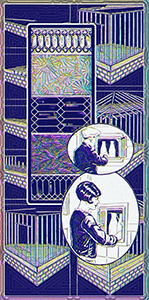
From one of my favorite collections, the Building Technology Heritage Library: a collage of three images. The underlying image is a series of eight plans showing how to construct a building using the company's "Ready-Cut" lumber, starting with a stone foundation and continuing to the framing of the walls. It's from the 1920 company Gordon-Van Tine catalog (Link1). Superimposed on that, from an undated (but probably 1920's) Hibbard and Co. Plumbing Supplies catalog (link2), a diagram showing the company's "Package and Milk Receiver." (We had one in my childhood home. We called it the "milk chute."). In the middle, from Harris Brothers' 1924 Catalog of building supplies (Link3), five samples arranged vertically of art glass and leaded glass for windows... This is a second-try. I made another attempt at this image yesterday, but it got demoted to the Rejects page because I wasn't pleased with it. I'm not used to the Building Technology Collection's very high-resolution scans; for example, yesterday's rejected image was absolutely huge: 2982 x 5962 pixels -- so large that some of my usual methods didn't work. It was instructive, but this image I reduced to 45%, to 1326 x 2667 pixels.
For maximum effect with my images, click on the image until it is full-size, which may be larger than your computer screen.
Sources:
Link1: archive.org/details/GordonVanTineHomes19200001
Link2: archive.org/details/HibbardsEtalPlumbingSupplies0001
Link3: archive.org/details/HarrisBrosCatalogNo1880001
Sunday, January 12, 2014
Construction and Milk Chute
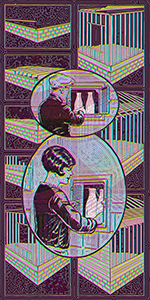
From one of my favorite collections, the Building Technology Heritage Library: the bottom image is composed of a chart in a catalog showing how to construct a building using "Ready-Cut" technology, starting with a stone foundation and continuing to the framing of the walls. It's from the 1920 Gordon-Van Tine Homes catalog (Link1). Superimposed on that, from an undated (but probably 1920's) Hibbard and Co. Plumbing Supplies catalog (link2), a diagram showing the company's "Package and Milk Receiver." (We had one in my childhood home in Detroit. We called it a "milk chute."). Because the Building Technology Collection does very high-resolution scans, the image is absolutely huge: 2982 x 5962 pixes.
For maximum effect with my images, click on the image until it is full-size, which may be larger than your computer screen.
Sources:
Link1: archive.org/details/GordonVanTineHomes19200001
Link2: archive.org/details/HibbardsEtalPlumbingSupplies0001
Saturday, January 11, 2014
Clams on Flower
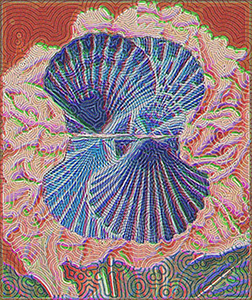
Moving now to the Internet Archives's Biodiversity collection, a collage of two illustrations from nature book. On top are four saltwater scallop shells from the 1913 Atlas de Poche des Coquilles des Côtes de France (Manche, Océan, Méditerranée) Communes, Pittoresques ou Comestibles (Link1). The originals are subtly covered in beige, pink, and light brown -- but I have inverted the colors here to their complements, so they show in various shades of blue. They are placed upon a picture of a pink peony from the 1801 Curtis's Botanical Magazine (Link2).
...
I'm not sure how strong this image is -- it may get moved to the 2014 Rejects folder. But I made a number of technical innovation working on it, mainly learning how to "group" Photoshop layers and organize them around previous selections... Another technical innovation is learning how to handle accent marks in different languages. It is shameful American provincialism that it took me so long to do this. The answer seems to be add a header on my webpage: meta charset="UTF-8"
For maximum effect with my images, click on the image until it is full-size, which may be larger than your computer screen.
Sources:
Link1: archive.org/details/atlasdepochedesc00dau
Link2: archive.org/details/mobot31753002719729
Friday, January 10, 2014
Zoologist's Daughter
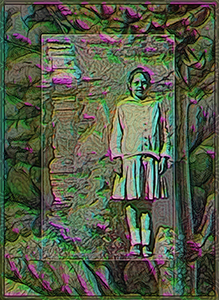
Again from the Biodiversity library, an image from the 1864 Harvard Memoirs of the Museum of Comparative Zoology, illustration for an article titled "Seasonal Depositions in Aqueo-Glacial Sediments," showing someone identified only as "little girl" standing to the right of a man-made cut in a hillside in Hanover, New Hampshire, on the Vermont side of the Connecticut River. The text explains that "progressive thinning" in the cut is caused by the retreat of a glacier. I speculate that the unexplained child is the daughter of article author Robert Sayles (1878-1942) -- or maybe just a passer-by.
The image of the girl standing next to the cut is superimposed on an illustration from an 1801 Curtis's botanical magazine (Link2), who shows a thistle-like plant. (The image is barely visible behind the top image.)
For maximum effect with my images, click on the image until it is full-size, which may be larger than your computer screen.
Sources:
Link1: archive.org/details/mobot31753003646202
Link2: archive.org/details/mobot31753002719729
Saturday, January 11, 2014
Dragonfly Embroidery
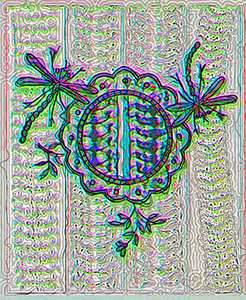
From the Internet Archive American Library text collection, a design from the 1914 Fine Hand Embroidery (Link1), a monogram design for "miniature photos, handkerchief cases, and book covers," featuring two dragonflies. It is superimposed on an illustration from a 2004 issue of a Belgian magazine on mollusks and seashells (Link2), showing (I believe) the patterns on some seashells.
...
A snow day in Philadelphia. Oatmeal and coffee. The sound of shovels and ice scrapers from the street below....
For maximum effect with my images, click on the image until it is full-size, which may be larger than your computer screen.
Sources:
Link1: archive.org/details/finehandembroide00jano
Link2: archive.org/details/novapextrimestri52soci
Friday, January 3, 2014
Lilypad and Talisman of Isis
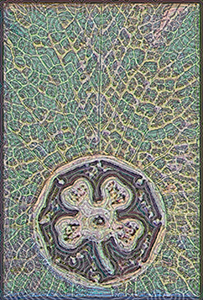
Background is a study of the delicate tracery of veins in the leaf of a species of water lily known as Nymphaea Gigantae, from the 1905 The Waterlilies: A Monograph of the Genus Nymphaea (Link1). At the bottom is an illustration from
the book of spells, El libro de San Cipriano (Link2), showing "The Talisman of Isis." (A talisman is an object which is believed to contain certain magical or sacramental properties which provide good luck for the possessor.) The text (if my Spanish translation is correct) says that the Egyptian Isis is known as "the good goddess," the patroness of good deeds (bienhechora). Wikipedia says she is a precursor of the Christian Madonna. Anyway, to my ignorant Irish eye, it looks like a four-leaf clover surrounded by indecipherable writing. Now Luck -- there is one four-leaf clover for every 10,000 three-leaf clovers -- Luck I understand. One of my father's favorite sayings was "If you're lucky, you don't have to be smart." He used it to deflect attention from good fortune or the fact that he was smart.
...
Today is the opening of the Plastic Club's New Member Show. I have three pieces in it. Here (in PDF form) is the Artist's Statement I'll be bringing with me. I wish myself Good luck!
For maximum effect with my images, click on the image until it is full-size, which may be larger than your computer screen.
Sources:
Link1: archive.org/details/waterliliesmonog00conruoft
Link2: archive.org/details/ellibrodesancipr00surf
Sunday, January 5, 2014
City Taunts Warrior
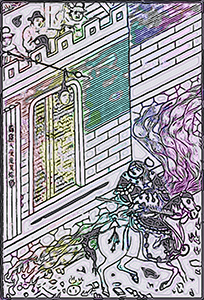
Again from the Universal Library, another illustration from what seems to be a multi-volume series of tales. It shows the defenders of a walled city waving a severed head before a fierce-looking mounted warrior. The book is titled, in Chinese,
????????????(??), or "Mr LEE Cheuk-yan Mr. Shingo criticism Chung Yee The Outlaws of the Marsh (12)" (Link1). I am not satisfied with my treatment of the image, but it is a good illustration, with strong contrast between the burly warrior on a horse and the unarmored, thin city people, hiding behind the parapets. And who does the head belong to? A woman? The warrior's child? ... I still remain an American provincial, unable to display Chinese characters and too lazy to include accent marks.
For maximum effect with my images, click on the image until it is full-size, which may be larger than your computer screen.
Sources:
Link1: archive.org/details/02111784.cn
Wednesday, January 8, 2014
Plastic Club Show
Tomorrow I deliver the three images below to the Plastic Club for their annual New Member's show, two of them appearing on the 2013 Archive.
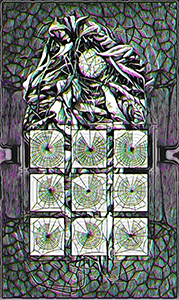
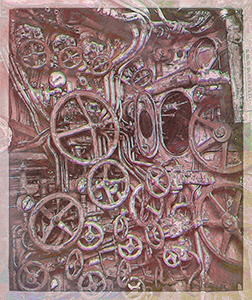
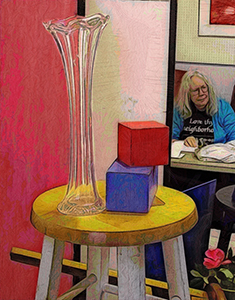 .
.
I think the middle image may possibly sell. How much should I charge? Well, assuming my work time is free, the production costs are $40.20 for the printing from an online printer and $38.06 for dry-mounting on foam-kore, and another $10 for adding wire to attach to wall, for a total of $88.26 for this 35 7/8" by 42 3/4" image. Of course, foam-kore mounting is not professional. There is no glass covering or rigid frame. Foam-kore warps and crushes easily.
If the buyer is content with foam-kore poster mounting, I'll give to them for $300. I think the deal I should offer to a buyer who wants high-end framing is either (1) I will make another print which will be delivered in a mailing tube to you or your framer for $600 or (2) I will make another print and pay for high-end framing for $1100.
What's odd is that the full-size image is available in the archive as a JPEG image. The only advantage to buying it from me, rather than printing from philly-bob.net, is that if you buy it from me you get a better image, the difference between JPEG and TIFF. Maybe if I sell an image for this kind of money, I should add a SOLD watermark on the archived, full-size image.
Wednesday, January 1, 2014
Butterfly Lily
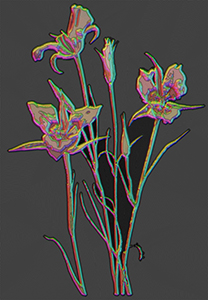
From the same book, still recovering from long-lived cold, a recolored flower. Original image (Link1) was Sagebrush Mariposa (Link1). Also calleld Mariposa Tulips or Butterfly Lilies. A huge image.
Sources:
Link1: archive.org/details/NorthAmericanwiIIIcWalc
Sunday, December 15, 2013
Ultrablack Berries
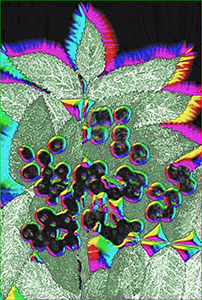
Doing unrewarding gruntwork archiving 2013 Philly-Bob.net and preparing for 2014. On fifth day of six-day cold, marked by cough and runny nose, general low IQ and energy. This image is from a 1925 book of North American Wildflowers (Link1). Actually, before radical recoloring, the illustration showed the Western Mount Ash, a relative of the apple tree.
Sources:
Link1: archive.org/details/NorthAmericanwiIIIcWalc
Saturday, December 14, 2013
12/17/2013
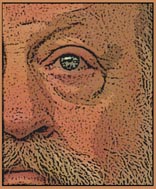




























































































































 .
.
